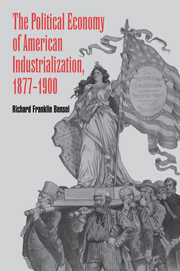Book contents
- Frontmatter
- Contents
- List of Tables
- List of Maps and Charts
- Preface
- Chapter 1 Introduction
- Chapter 2 Uneven Economic Development in the United States
- Chapter 3 Platform Demands, Party Competition, and Industrialization
- Chapter 4 Claims on Wealth and Electoral Coalitions
- Chapter 5 Political Construction of the National Market
- Chapter 6 Political Administration and Defense of the Gold Standard
- Chapter 7 Tariff Protection and the Republican Party
- Chapter 8 Conclusion
- Index
Chapter 6 - Political Administration and Defense of the Gold Standard
Published online by Cambridge University Press: 27 March 2010
- Frontmatter
- Contents
- List of Tables
- List of Maps and Charts
- Preface
- Chapter 1 Introduction
- Chapter 2 Uneven Economic Development in the United States
- Chapter 3 Platform Demands, Party Competition, and Industrialization
- Chapter 4 Claims on Wealth and Electoral Coalitions
- Chapter 5 Political Construction of the National Market
- Chapter 6 Political Administration and Defense of the Gold Standard
- Chapter 7 Tariff Protection and the Republican Party
- Chapter 8 Conclusion
- Index
Summary
During the Civil War the United States abandoned the gold standard, allowing the dollar to fluctuate in value. Inflation subsequently reduced the purchasing power of the dollar to a fraction of its antebellum value. After the war ended in 1865, the nation pursued a deflationary policy that ultimately returned the country to gold in 1879. From that point until the mid-1890s, an expanding world economy and the growing number of countries joining the international gold community caused a global deflation in prices that, within the United States as in every other national economy adhering to gold, gradually but inexorably redistributed wealth from debtors to creditors. Within the United States, given the very uneven pattern of regional development and distribution of investment capital, adherence to the gold standard thus heavily favored the industrial East over the capital-importing West and South. For this reason, one of the most important policy issues in national politics for most of the 1865–1900 period was whether the United States should adhere to gold or shift to some other standard, either paper money or silver, which would again inflate the currency.
POLITICAL UNDERPINNINGS OF THE GOLD STANDARD AND MONETARY STABILITY
From a political perspective, the gold standard was extremely vulnerable for most of the late nineteenth century. In fact, the nation would have switched from gold to silver and, finally, to paper at several points had the policy been forced to stand alone.
- Type
- Chapter
- Information
- The Political Economy of American Industrialization, 1877–1900 , pp. 355 - 456Publisher: Cambridge University PressPrint publication year: 2000



